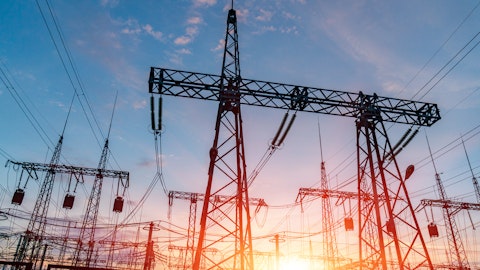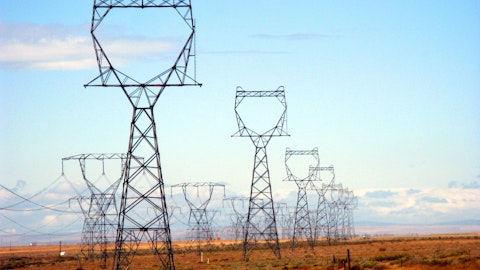We think we qualify for a somewhat streamlined regulatory approval process. But in the alternative, we just want to get ahead of the time frame. So we are going to align our marketing schedule with the regulatory approval. So we’d like to have the regulatory approval just before we signed any purchase and sale agreements because that will, of course, reduce uncertainty for everyone. And depending on which path the commission goes down, we would expect potentially middle of next year until sometime into 2025 to see transaction close. So that’s the sort of time frame we’re looking at for that.
Shar Pourreza : Got it. And the increasing value of the claims, does that present any challenges to the timing of the claims recoveries with the CPUC?
Maria Rigatti : No.
Pedro Pizarro : I’ll say no, remember, Shar, that in our TKM filing, the cost recovery application filing, we proposed a procedure for introducing amounts that have been settled after the filing date. And so it’s been contemplated. There will be some number of settlements coming in that we’ll be doing it beyond the numbers that we had initially filed. So the increase in claims will just fit into that final two procedure that we proposed.
Shar Pourreza : Okay. Perfect. That was good. And then just lastly, you obviously noted $0.39 of upside from the cost of capital mechanisms and the opportunity to sort of deploy it into customer-focused CapEx. I guess how long would it take you to deploy the incremental CapEx that the $0.39 of earnings would support? And I guess what mechanisms would you utilize to minimize that lag? Thanks, guys.
Maria Rigatti : Yeah. So we would be looking at a whole range of things in terms of deploying that $0.39 and that could range everywhere from further pushing forward on our initiatives in the field to improve the processes there. And so that would allow us to get capital efficiencies as well as O&M efficiencies. We’re going to keep looking at other opportunities in customer service and enhancing or improving the customer experience. We also have things that we want to do with support services and places in finance and regulatory affairs as examples. So we’re looking at that. And as I said earlier, for us, operational excellence, cost efficiencies really driving effectiveness in the business. It’s not a single year effort, like we are doing this on a multiyear basis. And so we’re going to be building on successes that we have next year into 2025. So I think this plan is still developing, but we would expect to see that ’25-’26-’27.
Shar Pourreza : Okay, perfect. Thank you, guys. Appreciate it.
Operator: Thank you. And our next question is from Angie Storozynski with Seaport. You may go ahead.
Pedro Pizarro : Hi, Angie.
Angie Storozynski : Hello. Thanks for letting me ask the question. So the first, again, I mean, those wildfire loss increases are very substantial. It just almost feels like it’s a moving target, right? We’re almost in the ninth inning. And every other quarter, we have these very big increases. It’s somewhat surprising, at least from our vantage point to see it this late into the process. And again, I’m clearly hopeful that by February, we will have a full picture, but it just feels like there is more of those increases to come. Would you disagree?
Pedro Pizarro : So listen, Angie, and you heard it in my comments. We know this is something that our shareholders are certainly taking notice of, and we are too as management and as shareholders. The reality is that every quarter, we test again, we reevaluate. And this quarter, a number of factors change. As I mentioned in my comments, it all adds down or boils down to, we’re seeing settlements coming in higher than expected. And so that now becomes the new best estimate. I think you’re right. We’re certainly looking forward to February and at least knowing what the claims finally are going to be for Woolsey. I do want to caution that that’s the deadline for claims filing might still take some time beyond the deadline to get all the details behind specific claims and really big into dose, that is a process, as you’ve seen over the last several years.
So we’ll continue to work at it. And our team is very focused on having a fair outcome as we go through all of this litigation, it’s going to be fair to people who were impacted by the fires, but it all has to be fair to our customers. And so we want to make sure that we do it as quickly as we can but taking the time needed to have a good thoughtful process and be able to demonstrate the prudency of our actions to the PUC.
Maria Rigatti : And maybe if I could just offer up one more thing, and I think Pedro kind of touched on in his last comment. It is a process that we have to go through, and we have to do an evaluation. The most important part of this process is getting through it and creating the certainty that comes with completion. Because that’s when we will be able to fully — we have a true-up mechanism in the TKM application. But when we’re done with all these processes, we will be able to go and get a final resolution also with the commission. So from our perspective, it’s getting through the claims and getting to the claims as quickly as we possibly can because that completion will create the certainty.
Angie Storozynski : Okay. But in the meantime, the total number of claims — or financing of claims grows in the cost of capital mechanism doesn’t really help me here, right, because those are not currently eligible for recovery. So the rising interest expense on those isn’t trued up? Is that –?
Maria Rigatti : Yeah. So we will — in our cost recovery application, we are going to file for recovery of the interest expense associated with claims — financing the claims payments. And the other aspect as well is that we are — and just to highlight another couple of numbers for you. We are about 85% complete with all of our individual plaintiffs clean to resolutions. So we are moving through the pile, if you will, expeditiously.
Angie Storozynski : Okay. And then changing topics. So you lowered your rate base projections — well, ’23-’24 or ’25. And you’re pointing out, obviously, upside to the CapEx on that rate base, mostly beyond ’25. So maybe some more details behind that? And then secondly, in your guidance, I’ve noticed some changes in the components, one of which is the $0.10 increase in the AFUDC the last quarter? And if you could just provide more color.





